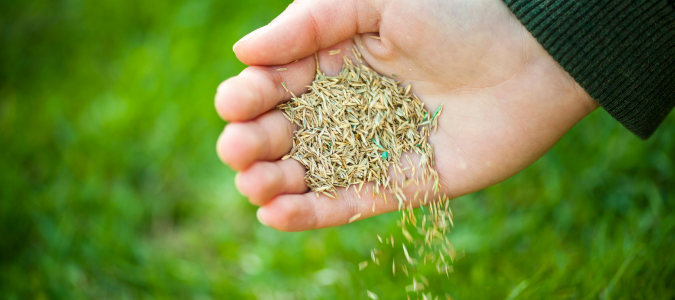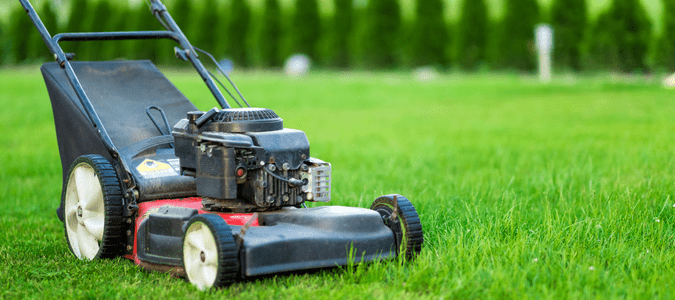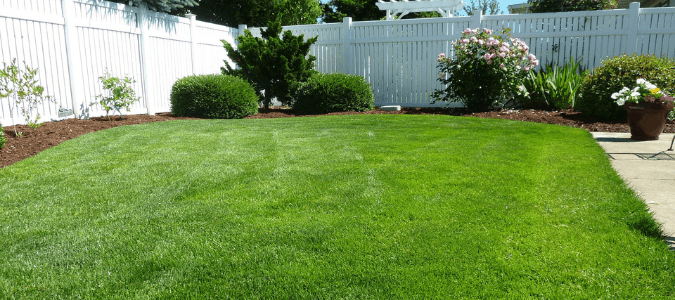Is it a good idea to plant new grass seeds in the winter months when your lawn is typically dormant? While it may sound counterproductive, grass seeding in the winter is actually an effective strategy that can help you get a head start on your new lawn before spring.
What to Know About Grass Seeding in Winter
Are you looking to revive your lawn by planting new grass seedlings in spring? You may not have to wait that long. Grass seeding in the winter, also known as “dormant seeding,” is a strategy many lawn care professionals use to ensure a lush lawn when the weather warms up.
As its name suggests, grass seeding in the winter means that you plant new grass seeds in the winter months. The seeds lie dormant until the weather changes and the soil is warm enough for the seeds to germinate.
While it may seem counterintuitive to plant new seeds in the winter season, dormant seeding has several benefits. First, your lawn will have a head start on the germination process. When you wait until the spring to plant new grass seeds, it takes time for the germination process to take effect.
Planting in the winter means the germination process will kick off as soon as the soil warms up, which can speed up growth. Thanks to dormant seeding, you can have a luscious green lawn earlier in the spring.
Next, it’s a good idea to plant new grass seeds in the winter because weeds are also dormant in the winter. The grass seeds will have a better chance of establishing roots since they won’t have to compete with as many weeds.
Another benefit to grass seeding in winter is that there is more moisture in the soil during the colder months. Throughout the winter, the grass seeds will be able to absorb more moisture than they could in the spring, which will also help speed up the germination process once the warm weather hits.
Lastly, if you live in a warm climate that typically experiences mild winters, your grass seeds may be able to germinate even in the winter months. As long as the ground does not freeze very often, your grass seedlings can get an even faster head start on the growth process.
Grass seeding in the winter in warm climates is a great idea because you could have a healthy fully grown lawn even earlier in the new year.
When to Work With a Professional
Not sure if grass seeding in the winter is the right choice for your lawn or want to know how much grass seed you need? The best option is to consult with a lawn care professional. They can evaluate your lawn and offer expert advice that is personalized to your lawn’s needs.
If you do decide to move forward with dormant seeding, working with a lawn care professional to get the job done is recommended. They can choose the right seed for your lawn and the perfect timing to ensure success.
Additionally, a lawncare specialist can take care of your after-seeding maintenance, such as fertilization and water schedules. Working with a professional is the way to go for the best results.
When Should You Stop Mowing Your Lawn Before Winter?
It’s important to stop mowing your lawn during the winter when your grass goes dormant. However, when exactly you should stop mowing your lawn depends on various factors.
First, it depends on what type of grass turf you have. For example, cool-season grasses can continue to grow in lower temperatures, whereas warm-season grasses stop growing shortly after the temperature starts to go down.
Cool-season grasses, such as Kentucky bluegrass and fescue, typically stop growing when the temperatures consistently drop to around 45 to 50 degrees Fahrenheit. On the other hand, warm-season grasses, such as bermuda grass and zoysia grass, usually stop growing when the temperatures consistently stay below 60 degrees Fahrenheit.
Another factor determining when you should stop mowing your lawn before winter is your climate. If you live in a cooler climate, you should stop mowing your lawn in the late fall, such as late October or early November.
However, if you live in a warm climate that does not consistently reach low temperatures throughout the entire season, your grass may grow late into winter. That means you likely won’t stop mowing until late November or early December.
Considering your climate is an extremely important factor in this process, so it’s important not to overlook its influence.
One of the best ways to determine when to stop mowing your lawn before winter is to observe your lawn’s growth rate. This method is especially helpful if you live in a “transition zone,” a climate where cool-season and warm-season grasses can thrive.
As long as your grass is still growing, you should continue to mow. If you live in a warm climate where the grass continues to grow late into the year, its growth rate will likely slow down as the temperatures start to drop. When this happens, you can mow less frequently than you would in the warmer months.
When you notice that your grass has stopped growing, you can put away your mower for the winter. Another rule of thumb is to mow your grass for the last time around one week before the first frost of the winter.
If you still aren’t sure when to stop mowing your lawn for winter, contact a lawn care specialist for expert assistance.
How Long After Planting Grass Seed Can You Mow?
If you are eagerly awaiting your new grass seed to sprout into a beautiful and fully grown lawn, remember to practice patience. It’s important that you do not mow new grass too soon after planting, especially if you are growing it from seedlings.
New grass seedlings need enough time to take root in the soil. A strong root system leads to healthy grass blades, which is why you don’t want to rush the process. When you mow new grass too soon, you will hurt its chances of growing into a lush lawn.
The general rule is that you need to wait around two months after seeding before you mow your new grass for the first time. However, there are also a few signs you can look out for to tell when your grass is ready for its first trim.
First, evaluate the height of your new grass. It is typically safe to mow once the grass blades reach three to four inches in height.
Next, you can check your new grass for established roots. Try gently tugging on a few grass blades. If the grass easily pulls up out of the soil, it does not have firmly established roots. However, if you feel resistance when you pull on the grass, then the roots are strong enough to withstand mowing.
Finally, consider your lawn’s density. If your lawn has grown in a uniform pattern and has a lush density, you can assume that the germination process was successful. Since the lawn is growing properly and healthfully, you can mow it for the first time.
If you are nervous about mowing your lawn for the first time after seeding, it’s a good idea to consult with a lawn care specialist. They can advise you on the right time to mow in order to avoid damage to your new grass. In addition, they can handle the job for you and take the task off your plate.
Work With the Professionals to Achieve the Lawn of Your Dreams
You can get started on a beautiful spring lawn in the winter by utilizing dormant seeding. Seeding in the winter offers several benefits, and it is recommended that you consult with a lawn care specialist to determine if it’s right for your lawn.
Working with the experts can ensure that your lawn remains healthy throughout the seasons, including during the winter months and after planting new grass. To achieve a beautiful lawn that your family can enjoy, contact your local lawn care service professional.
ABC Can Keep Your Yard Healthy And Green
Keeping your lawn healthy isn’t just a source of beauty and pride; it is also a practical measure for keeping weeds away. At ABC Home & Commercial Services, we know all about creating and maintaining dense, healthy lawns for our satisfied customers. If your lawn is becoming an eyesore and the overseeding process described above sounds like a little too much for you to handle, ABC is here to help. Our lawn specialists can reclaim and revive tired, weedy, patchy lawns and maintain thriving ones so your yard stays beautiful for years.


